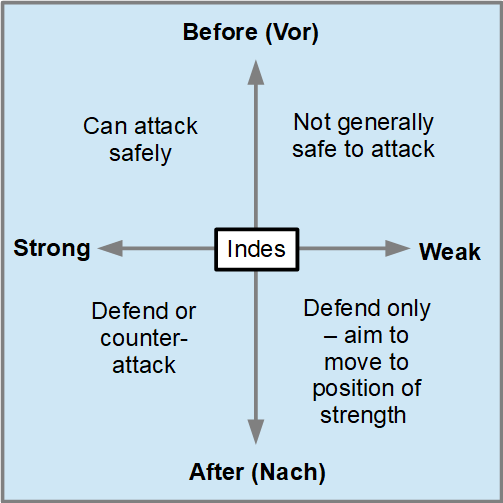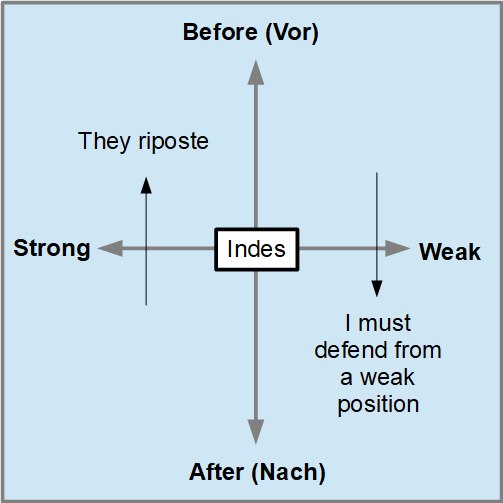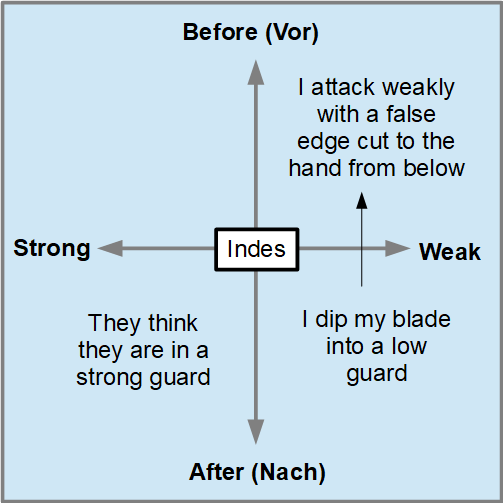My Approach to 15th-Century German Fencing Theory
- HEMA 101 admin
- Jul 19
- 8 min read
Updated: Jul 21
This is my current approach to using 15th-century German fencing theory. You may have a different interpretation—and indeed, the historical sources are suitably vague—so many readings are possible.
The five words
German fencing theory can be thought of as consisting of two dichotomies (two pairs of opposing concepts) held together by a fifth, mediating concept. Together, they form the five words:
Before (Vor)
After (Nach)
Strong
Weak
Indes

Vor and Nach
Vor has multiple meanings:
Being the first to act
Presenting a threat that’s recognised
Compelling your opponent to respond
Examples of Vor actions include:
Having your point online (aimed at your opponent)
Attacking with a cut or thrust
Advancing toward your opponent
Nach also carries several meanings:
Being the second to act
Recognising a threat
Reacting to counter that threat
Examples of Nach actions:
Having your point offline (not directed at your opponent)
Parrying or attacking your opponent’s blade
Retreating
Note: Interpreting actions that simultaneously threaten and defend—like counterattacks—can be tricky. Is it Vor because it threatens? Or Nach because it defends? I’d argue it depends on timing, intent, and perception.
Vor and Nach define how the fencers interact. If both acknowledge and respond to each other’s actions, one is in Vor and the other in Nach. However, if the opponent ignores your threat and initiates their own, both may act in Vor—potentially resulting in a double hit. You can't win a sword fight if you’re dead.
So, if you want to work in the Vor, you'd better be damned sure your opponent is in the Nach.
How can you ensure that? This is where Strong and Weak come in.
Strong and weak
There are (at least*) five elements that determine strong and weak:
Element | Strong | Weak |
Position | Blade above theirs | Blade below theirs |
Forte or Foible | Forte of my sword | Foible of my sword |
Direction | Pointing towards their sword | Pointing away from their sword |
Pressure | Hard pressure | Soft pressure |
Distance** | Shorter path to attack | Longer path to attack |
*You could also add 'good skeletal structure' as well as physical strength.
**I've included this last one, but it could be considered part of Vor and Nach too. My reasoning for including is that it is about speed, so you can bring to bear your 'strength' over a shorter distance.
For example, my opponent might be stronger because they have their blade above mine. But I can still parry using my Forte, or I can parry using my Foible and point my sword into their attack. So, different strength elements can play off each other. Something to note, however, is that strong and weak only really has meaning if you have a way to project that strength onto your opponent's sword. For example, if you are in a high guard and they are low, but you are unable to cross their blade with your attack, then being 'strong' isn't massively helpful to you.
Zufechten
Many assume Strong and Weak only matter in the bind—but that’s a misconception. They're vital during Zufechten (the pre-fencing), where guard posture determines who can safely act in the Vor.
During the Zufechten, I typically aim for a stronger position relative to my opponent. That means choosing a guard that, from my perspective, does one or more of the following:
Places my strong over their weak
Positions my sword above theirs or allows me to attack over it
Encourages their point to aim away from my line of attack
Enables me to exploit their foible during an attack
Let's me cross over their sword—either to strike or parry
Blocks or deters their direct attack, forcing them to “go the long way round”
Being stronger allows safer attacks and better defense. It forces your opponent either into the Nach—or into an ill-advised Vor from a weak position, which I can counter.
This dynamic is why guards often change during the Zufechten. One fencer establishes a stronger posture; the other adapts to regain advantage.
Kreig
In the Krieg (the war—the phase after attack and parry), Strong and Weak become tactile sensations. It's harder to explain in writing, but the essence remains: strong controls weak, and weak gives in to strong, and using these against each other is where the art lies. You also have concepts of being hard and soft (the pressure applied to the blade). A good rule of thumb is, if I am weak, it’s safer to work from Nach to build strength, rather than attack prematurely from Weak. However, if your opponent is overly strong in the bind and applying hard pressure, you can give in to that strength by going soft, allowing you to free yourself and/or attack.
If both fencers strive to be Strong, size and power prevail—and this often turns into grappling.
Making tactical choices
The relationship between Vor, Nach, Strong, and Weak is fairly simple: any action is either Vor or Nach & Strong or Weak. While not absolute, these guidelines serve as valuable heuristics:

We can use this to model other choices we could make, for example:
Intended Action | Recommended State |
Defend | Strong & Nach |
Counter-attack | Strong & Nach |
Attack in opposition | Strong and Vor |
Bait the opponent | Feign weakness |
Attack (from Weak) | Transition to Strong |
Attack (from Strong) | Proceed—opportunity is present |
Everything is relative to your opponent. We can be in four combinations, and our opponent can also be in four combinations. This requires a more complicated matrix (below). I've included colour coding - green to indicate the safest combinations for us, orange to indicate less than ideal combinations, and red to indicate the least safe options. However, this is probably too much and too complicated to be of practical use. I include it only as a curiosity.

Note: The colour coding really depends on the context. For instance, Vor & Weak versus Nach & Strong might be poor in Zufechten, yet techniques like the Duplieren or Ceding Thrust thrive on exploiting overly strong parries. This is where Indes shines.
Indes
Indes ("in the moment") is the marriage of judgement and action. It’s the recognition of your state—Strong or Weak, Vor or Nach—and the ability to respond immediately.
In combat, states shift rapidly. Indes allows you to assess and react, not merely to hit your opponent—but to do so from a dominant position.
Think of Indes as the pivot point in this model.
It also means acting instantaneously—shifting from Strong to Weak, Nach to Vor faster than your opponent. Consider:
You attack in Vor & Strong
Your opponent parries too strongly
You exploit this by transitioning to Weak and curving around their blade—Duplieren
Get the timing wrong, and you expose yourself. But done right, you're attacking from Weak while they remain caught in Nach.
That gives another translation of Indes as "within." It gives you the ability to work within their action and to upset the expected order of things, so that strong no longer dominates weak, and their Vor turns into Nach.
Indes also lets you threaten from a seemingly weak position. For example, in rapier, if my opponent pushes my blade aside, I might hint at a Ceding Thrust. Even if I’m technically Weak, they may hesitate to attack if they sense danger.
There are many “exceptions that prove the rule.” The Five Words don't model all fencing intricacies—but they offer a reliable framework.
Examples
Counter-attack
This is quite a simple example. I am in a high guard, they are in a similar guard. They attack and I counter-attack with a stronger (e.g. higher) attack. My attack parries and hits simultaneously. (Some would consider a counter-attack to be a Vor action, I consider it to be a Nach action).

Attack in opposition
This is similar to above, but I attacked first, they attacked second, my attack lands and simultaneously parries their attack.

Parry-riposte
This is a more complicated example as it involves a number of attacks and parries:
Me and the opponent are in Zufechten.
I gain an advantageous guard and attack from a position of strength. They are in a position of weakness and defend in the Nach.

They must parry strongly with their Forte (which puts me into Weak Vor).

I am now in Weak Nach, because they have my Foible on their Forte. They have the shorter path to the next attack and so can make a riposte from a strong position - Strong Vor. If I attack Weakly, we will double or I will be hit first, so I must attempt to parry from my weak position.

I parry from a weak position with a hanging parry, using the Forte of my blade, which causes their attack to slide off into a weak position...

...and I return my own cut from above. However, they do not attempt a parry, and instead attempt to make another attack. I hit them.

You can see how the fencers are moving about the matrix with their actions, trying to climb from bottom right to top left, while pushing their opponent down into bottom right. In this example, both fencers are moving around the matrix in a clockwise fashion, as if both fencers are chasing each other. Eventually one of the fencer reacts too slowly, or makes the wrong decision, and the other fencer 'catches up' with them.
Feint-in-time
We are both in a strong position. We both attack.

I abort my attack and redirect it into a parry.

Duplieren or ceding thrust
I attack strongly, they parry strongly. I redirect my attack around their blade with a cut or thrust. I can do this because they were overly strong in their parry, and their point was offline.

This is a classic example of Indes. I have performed two actions for my opponent's one action, and I have subverted the expect order of things: in this case, weak triumphs over strength.
Hand snipe from below
They are in a strong guard - or they think they are. I dip down into a low (weak) guard. I make a false edge cut at their hands from below.

This works because they are in the Nach, and few guards really defend against direct cuts from below. If they were actually in the Vor, my hand snipe would have been ill-advised, to say the least.
Thrust from a low guard
I wanted to try to include an example where the fencers travel through the Indes box in the middle. This doesn't mean it is an Indes action - there is no significance to the Indes box in the middle. It is just to show that the fencers don't always travel around the outside of the diagram.
In this example, I am in Fools guard. They threaten an attack from above, and I thrust in Ox before they attack.

We could split hairs on this one. Do I truly pass through the Indes box, or is my attack transitioning via one of the other boxes? You decide.
Final word
The Five Words are a model—not a law. All models are wrong; some are useful. I hope this one proves more useful than not.
In practice, the Five Words become a kind of instinct. Not just the physical sensation of blade contact, but the feeling of control, threat, and dominance. You feel it in your chest and your head more than you do using conscious thought.
In this way, the five words are really just trying to rationalise something that good fencers do instinctively. In other words, German fencing isn't based on the five words - the five words is simply an attempt to model fencing.


this is really good. i dont know much about german fencing but this breaks down the exchange (in general) that happens in a lot of other sports that arent MMA. plus the descriptions of attacks are actually good without getting muddled at some point. its clear you can apply these generalized descriptions to actual situations, but you dont need to name the specific guard in order to describe them, making this perfect explanatory material. props to the work that went into this.
really cool model, thanks for sharing